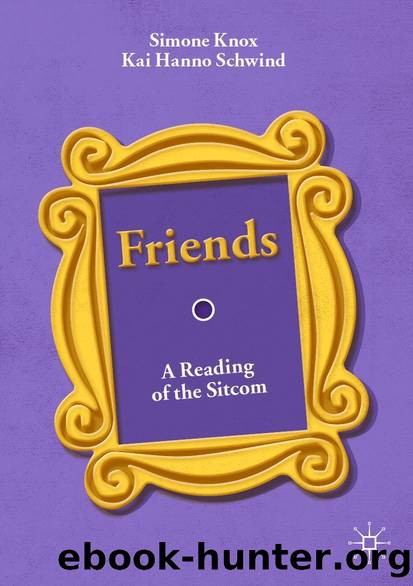Friends by Simone Knox & Kai Hanno Schwind

Author:Simone Knox & Kai Hanno Schwind
Language: eng
Format: epub
ISBN: 9783030254292
Publisher: Springer International Publishing
Then once the home video shows a (full-screen) shot of a younger Ross looking frame left, distraught to see Rachel leaving with her late date, a cut to present-day Ross looking frame right shows that Ross is looking at his younger self across the shot pattern, connecting to the painful emotions of this past moment. Then Rachel walks across the set to Ross to reconcile with him (following their recent falling-out), which, as Burrows recalls, âIâm not sure if everyone on the set was a fan of immediately, but itâs really dramaticâ. This well-remembered moment from the show is made especially interesting by both the length of the walk (which enables the cameras to capture the emotionality played out on Anistonâs face) as well as Aniston very briefly dropping her gaze to ensure she can manoeuvre around the couch. So, both the depth and (especially) the length of the space are being deployed as Rachel symbolically and physically traverses the space between Ross and herself, reflecting Burrowsâs interest in complex blocking. As Ross and Rachel reconcile accompanied by non-diegetic cheersâwhich, Kevin S. Bright in the DVD commentary observes, âreally points out an intimacy that the audience has with this showââand Phoebeâs insistence that Ross is Rachelâs âlobsterâ, a reaction shot of the four friends captures them framed next to the fictional television screen, only this time with their emotional engagement visible on their faces. With the prom video stopped, the television screen no longer shows the past emotional pain and separation, but as a black mirror reflects the group in their present unity.
As this close analysis and the previous examples suggest, any argument that the absence of proscenium-style staging is what facilitates a creative use of space in sitcom, is in need of substantial development. Just as âthe room is [â¦] an actively shaping environmentâ, as Williams (2011 [1974], 12) argued regarding television space, so the space here is actively and productively shaped. (Phil Chidester [2008] considers the function of the couches in relation to the exercise of white privilege within the programme, which we will consider in Chapter 5.) The placement of the couch in Monicaâs apartment, while still allowing planimetric visual access for the audience, enables a nuanced use of space that is not reductively determined by the proscenium arch . In âThe One with the Prom Videoâ, the use of space engenders a scene with considerable visual complexity, enhancing the emotional significance of the storytelling because the television set is not a disconnected, disruptive presence but embedded within the familiar space. It thus benefits from the intimacy that marks the space, but it also contributes to it, because the positioning of the couch facilitates a regime of looking where the audience not only watches the characters and their reactions, but also watches with them. This particular viewer engagement brings us to the final two sections of this chapter, in which we will consider how multi-camera sitcom engenders a particular viewing experience for the audience that further informs the strategy of intimacy in Friends.
Download
This site does not store any files on its server. We only index and link to content provided by other sites. Please contact the content providers to delete copyright contents if any and email us, we'll remove relevant links or contents immediately.
Call Me by Your Name by André Aciman(20371)
Ready Player One by Cline Ernest(14522)
How to Be a Bawse: A Guide to Conquering Life by Lilly Singh(7384)
Wiseguy by Nicholas Pileggi(5669)
The Kite Runner by Khaled Hosseini(5082)
On Writing A Memoir of the Craft by Stephen King(4863)
Audition by Ryu Murakami(4840)
The Crown by Robert Lacey(4722)
Call me by your name by Andre Aciman(4613)
Gerald's Game by Stephen King(4571)
Harry Potter and the Cursed Child: The Journey by Harry Potter Theatrical Productions(4439)
Dialogue by Robert McKee(4321)
The Perils of Being Moderately Famous by Soha Ali Khan(4169)
Dynamic Alignment Through Imagery by Eric Franklin(4115)
Apollo 8 by Jeffrey Kluger(3635)
Seriously... I'm Kidding by Ellen DeGeneres(3575)
The Inner Game of Tennis by W. Timothy Gallwey(3575)
How to be Champion: My Autobiography by Sarah Millican(3554)
Darker by E L James(3475)
